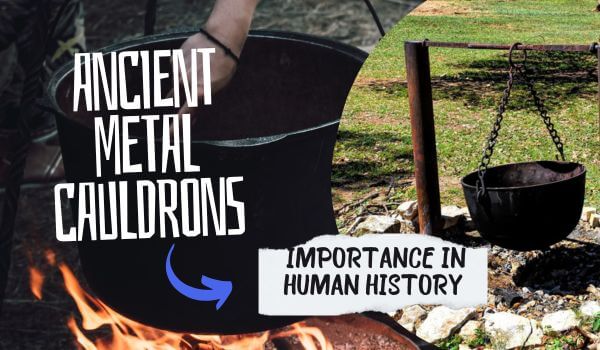This article delves into the importance of ancient metal cauldrons in human history, shedding light on their cultural, technological, and archaeological significance.
The human history is filled with fascinating artifacts that offer glimpses into our ancestors' lives and beliefs.
Among these intriguing secrets are ancient metal cauldrons, vessels that have transcended time and cultures to play a significant role in shaping our understanding of the past.
From their origins in prehistoric times to their symbolic significance in various civilizations, these humble cooking pots have left an indelible mark on our collective history.
The Birth of Cauldrons
Early Origins
Ancient metal cauldrons, often made of bronze, iron or copper, have roots dating back thousands of years. Archaeological finds have revealed their presence in various ancient civilizations, dating back to the Bronze Age (around 3300–1200 BCE).
Early pans were usually made by skilled metalworkers who used their craftsmanship to craft these vessels.
Technological Advancements
The development of metalwork technique marked a important moment in the history of cauldrons. As societies progressed from the Bronze Age to the Iron Age, metal cauldrons evolved from simple, utilitarian vessels into intricate, ornate pieces of art.
The refinement of metal smelting and casting techniques allowed for greater creativity in cauldron design and decoration, showcasing human ingenuity and skill.
Culinary and Practical Uses
Cooking and Food Preparation
The primary function of ancient metal cauldrons was as cooking vessels. These durable containers were indispensable for cooking large quantities of food, making them vital to the sustenance and survival of ancient communities.
They were particularly crucial during communal gatherings, festivals, and religious ceremonies.
Brewing and Alchemy
Cauldrons also played a pivotal role in the development of brewing and alchemical practices.
In ancient times, cauldrons were used to brew potions, elixirs, and medicines, contributing to the evolution of early pharmacology and chemistry.
These practices laid the groundwork for the scientific advancements that would follow in later centuries.
Symbolism and Cultural Significance
Mythology and Religion
Ancient metal cauldrons often featured prominently in myths, legends, and religious rituals. One of the most famous examples is the Cauldron of Dagda from Celtic mythology, believed to provide an endless supply of food and drink. Such legends reflect the vital role cauldrons played in sustaining life and the spiritual beliefs associated with them.
Rituals and Ceremonies
Various cultures incorporated cauldrons into their religious and ceremonial practices. For instance, the ancient Greeks used cauldrons in sacred rites, while the Chinese used them as part of ancestor worship.
The use of cauldrons in these rituals underscored their symbolic importance as vessels of transformation and renewal.
Archaeological Insights
Historical Discoveries
Archaeological excavations have unearthed ancient metal cauldrons in diverse geographical locations, from Europe to Asia.
These discoveries have provided valuable insights into the dietary habits, trade networks, and metallurgical techniques of ancient societies.
By analyzing the materials and craftsmanship of these cauldrons, researchers have pieced together a richer tapestry of human history.
Cultural Exchange
The presence of cauldrons in various parts of the world has shed light on ancient trade routes and cultural exchanges. For example, the Silk Road, a historic trade network connecting Asia to the Mediterranean, facilitated the exchange of goods, including cauldrons. These artifacts serve as tangible evidence of the interconnectedness of ancient civilizations.
Conclusion
Ancient metal cauldrons occupy a unique place in human history, transcending their utilitarian origins to become symbols of culinary innovation, cultural significance, and technological progress.
These vessels, born in the crucible of the Bronze and Iron Ages, have left an indelible mark on our understanding of ancient civilizations, their rituals, and their artistic achievements.
From the kitchens of ancient villages to the pages of mythological epics, cauldrons have played an enduring role in shaping our world, offering tantalizing glimpses into the lives and beliefs of those who came before us.
As we continue to uncover and study these remarkable artifacts, we gain a deeper appreciation for their importance in human history.






0 Comments